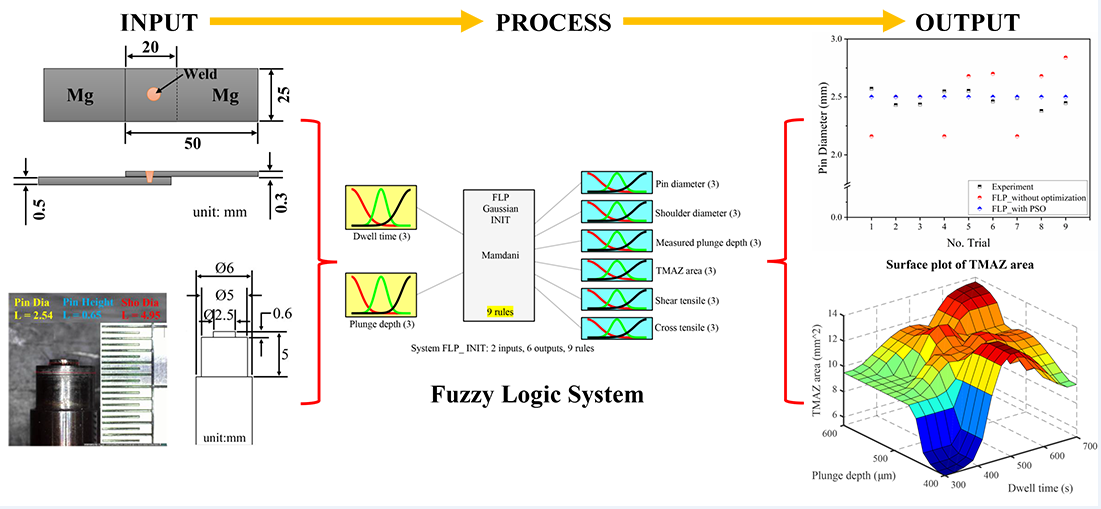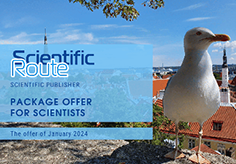Розробка моделі нечіткої логіки для прогнозування якості точкового зварювання мікротертям з перемішуванням (µFSSW) за допомогою методу рою часток
DOI:
https://doi.org/10.15587/1729-4061.2024.297617Ключові слова:
магнієвий сплав, система нечіткої логіки, Мамдані, гауссова функціяАнотація
Точкове зварювання мікротертям з перемішуванням (µFSSW) має вирішальне значення в мікроелектроніці та прецизійному виробництві. Для досягнення найвищої якості зварних швів необхідне всебічне розуміння складних зв’язків між різними параметрами. Дане дослідження спрямоване на покращення прогнозування якості зварного шва µFSSW шляхом впровадження передових методів оптимізації. Оптимізація з використанням нечіткої логіки застосовується для моделювання невизначеностей, а метод рою часток (PSO) використовується для точного налаштування параметрів для підвищення точності. Система нечіткої логіки використовує гауссові функції в якості функцій приналежності, організованих за допомогою дев’яти баз правил. Результати чітко демонструють, що у поєднанні з методом рою часток модель нечіткої логіки значно підвищує точність. Удосконалена модель підвищує точність визначення діаметра штифта, діаметра заплечика, зони термомеханічного впливу (TMAZ) і межі міцності при поперечному розтягуванні. Модель, оптимізована за допомогою PSO, показує нижчу точність прогнозування глибини занурення та межі міцності при розтягуванні при зсуві. Триваюче зниження значень середньоквадратичної помилки (RMSE) підкреслює складність результатів. Оптимізація значно покращує здатність моделі прогнозувати конкретні показники якості зварного шва, про що свідчить зменшене значення RMSE діаметра штифта 0,07. Сукупні результати демонструють оптимізовану модель системи нечіткої логіки (FLS), здатну точно прогнозувати якість зварного шва µFSSW, демонструючи адаптивність у різних умовах. Помітне збільшення точності, що досягає 76 % після оптимізації моделі нечіткої логіки за допомогою PSO, служить свідченням ефективності використовуваних методик в підвищенні точності і надійності прогнозування якості зварних швів µFSSW
Спонсор дослідження
- The author expresses gratitude to the Mechanical Engineering Laboratory at Hasanuddin University for their invaluable help with this study. This laboratory's dedicated space and tools have been accommodating in running experiments, gathering data, and analyzing it.
Посилання
- Sen, M., Shankar, S., Chattopadhyaya, S. (2020). Micro-friction stir welding (μFSW) – A review. Materials Today: Proceedings, 27, 2469–2473. https://doi.org/10.1016/j.matpr.2019.09.220
- Balasubramanian, V. (2008). Relationship between base metal properties and friction stir welding process parameters. Materials Science and Engineering: A, 480 (1-2), 397–403. https://doi.org/10.1016/j.msea.2007.07.048
- Singarapu, U., Adepu, K., Arumalle, S. R. (2015). Influence of tool material and rotational speed on mechanical properties of friction stir welded AZ31B magnesium alloy. Journal of Magnesium and Alloys, 3 (4), 335–344. https://doi.org/10.1016/j.jma.2015.10.001
- Ugender, S., Kumar, A., Reddy, A. S. (2014). Microstructure and Mechanical Properties of AZ31B Magnesium Alloy by Friction Stir Welding. Procedia Materials Science, 6, 1600–1609. https://doi.org/10.1016/j.mspro.2014.07.143
- Sevvel, P., Jaiganesh, V. (2014). Improving the Mechanical Properties of Friction Stir Welded AZ31B Magnesium Alloy Flat Plates through Axial Force Investigation. Applied Mechanics and Materials, 591, 11–14. https://doi.org/10.4028/www.scientific.net/amm.591.11
- Badwelan, A., M. Al-Samhan, A., Anwar, S., Hidri, L. (2021). Novel Technique for Enhancing the Strength of Friction Stir Spot Welds through Dynamic Welding Parameters. Metals, 11 (2), 280. https://doi.org/10.3390/met11020280
- Verma, M., Ahmed, S., Saha, P. (2021). Challenges, process requisites/inputs, mechanics and weld performance of dissimilar micro-friction stir welding (dissimilar μFSW): A comprehensive review. Journal of Manufacturing Processes, 68, 249–276. https://doi.org/10.1016/j.jmapro.2021.05.045
- Kumar, S. S., Ashok, S. D. (2014). Development of Acoustic Emission and Motor Current Based Fuzzy Logic Model for Monitoring Weld Strength and Nugget Hardness of FSW Joints. Procedia Engineering, 97, 909–917. https://doi.org/10.1016/j.proeng.2014.12.366
- Senthilkumar, G., Mayavan, T., Manikandan, H. (2022). Prediction of mechanical characteristics of friction welded dissimilar EN 10028P 355 GH steel and AISI 430 steel joint by fuzzy logic analysis. Materials Today: Proceedings, 68, 2182–2188. https://doi.org/10.1016/j.matpr.2022.08.419
- Padmanaban, R., Vignesh, R. V., Povendhan, A. P., Balakumharen, A. P. (2018). Optimizing the tensile strength of friction stir welded dissimilar aluminium alloy joints using particle swarm optimization. Materials Today: Proceedings, 5 (11), 24820–24826. https://doi.org/10.1016/j.matpr.2018.10.280
- Eren, B., Guvenc, M. A., Mistikoglu, S. (2020). Artificial Intelligence Applications for Friction Stir Welding: A Review. Metals and Materials International, 27 (2), 193–219. https://doi.org/10.1007/s12540-020-00854-y
- Membala, S. B., Sutresman, O. S., Arsyad, H., Syahid, M., Widyianto, A. (2022). Indentifying the effect of micro friction stir spot welding (µFSSW) parameters on weld geometry, mechanical properties, and metallography on dissimilar materials of AZ31B and AA1100 . Eastern-European Journal of Enterprise Technologies, 4 (12 (118), 13–21. https://doi.org/10.15587/1729-4061.2022.263350
- Karuthapandi, S., Ramu, M., Thyla, P. R. (2017). Effects of the use of a flat wire electrode in gas metal arc welding and fuzzy logic model for the prediction of weldment shape profile. Journal of Mechanical Science and Technology, 31 (5), 2477–2486. https://doi.org/10.1007/s12206-017-0445-1
- Mystica, A., Senthil kumar, V. S., Sakthi abirami, B. (2022). Analysis and prediction of uncertain responses using regression and fuzzy logic for friction stir welding of AA2014 under n-MQL. Journal of Intelligent & Fuzzy Systems, 43 (3), 2375–2390. https://doi.org/10.3233/jifs-213032
- Baskoro, A. S., Riyanto, A., Arifardi, M. F., Rupajati, P. (2020). Influence of Tools Diameters and Plunge Depth on Mechanical Properties of Micro Friction Stir Spot Welding Materials A1100. IOP Conference Series: Materials Science and Engineering, 727 (1), 012008. https://doi.org/10.1088/1757-899x/727/1/012008
- Shanavas, S., Dhas, J. E. R. (2018). Quality Prediction Of Friction Stir Weld Joints On AA 5052 H32 Aluminium Alloy Using Fuzzy Logic Technique. Materials Today: Proceedings, 5 (5), 12124–12132. https://doi.org/10.1016/j.matpr.2018.02.190
- Hussein, H. K., Shareef, I. R., Zayer, I. A. (2019). Prediction of spot welding parameters using fuzzy logic controlling. Eastern-European Journal of Enterprise Technologies, 5 (2 (101)), 57–64. https://doi.org/10.15587/1729-4061.2019.172642
- Alghannam, E., Lu, H., Ma, M., Cheng, Q., Gonzalez, A. A., Zang, Y., Li, S. (2019). A novel method of using vision system and fuzzy logic for quality estimation of resistance spot welding. Symmetry, 11 (8), 990. https://doi.org/10.3390/sym11080990
- Hynes, N. R. J., Kumar, R., Sujana, J. A. J. (2016). Modeling of process parameters of friction stud welding using fuzzy logic system. International Journal of Advanced Engineering Technology. Available at: https://www.academia.edu/62336555/Modeling_of_Process_Parameters_of_Friction_Stud_Welding_Using_Fuzzy_Logic_System
- Shehabeldeen, T. A., Elaziz, M. A., Elsheikh, A. H., Zhou, J. (2019). Modeling of friction stir welding process using adaptive neuro-fuzzy inference system integrated with harris hawks optimizer. Journal of Materials Research and Technology, 8 (6), 5882–5892. https://doi.org/10.1016/j.jmrt.2019.09.060
- Lashin, M. M. A., Al Samhan, A. M., Badwelan, A., Khan, M. I. (2022). Control of Static and Dynamic Parameters by Fuzzy Controller to Optimize Friction Stir Spot Welding Strength. Coatings, 12 (10), 1442. https://doi.org/10.3390/coatings12101442
- Choudhury, B., Chandrasekaran, M. (2023). Electron Beam Welding Investigation of Inconel 825 and Optimize Energy Consumption Using Integrated Fuzzy Logic-Particle Swarm Optimization Approach. International Journal of Fuzzy Systems, 25 (4), 1377–1399. https://doi.org/10.1007/s40815-022-01431-8
- Mounika, G., Rajyalakshmi, K., Rajkumar, G. V. S., Sravani, D. (2023). Prediction and optimization of process parameters using design of experiments and fuzzy logic. International Journal on Interactive Design and Manufacturing (IJIDeM). https://doi.org/10.1007/s12008-023-01446-x

##submission.downloads##
Опубліковано
Як цитувати
Номер
Розділ
Ліцензія
Авторське право (c) 2024 Hairul Arsyad, Semuel Boron Membala, Agus Widyianto, Muhammad Syahid, Lukmanul Hakim Arma, Rudi, Saiful Mangngenre

Ця робота ліцензується відповідно до Creative Commons Attribution 4.0 International License.
Закріплення та умови передачі авторських прав (ідентифікація авторства) здійснюється у Ліцензійному договорі. Зокрема, автори залишають за собою право на авторство свого рукопису та передають журналу право першої публікації цієї роботи на умовах ліцензії Creative Commons CC BY. При цьому вони мають право укладати самостійно додаткові угоди, що стосуються неексклюзивного поширення роботи у тому вигляді, в якому вона була опублікована цим журналом, але за умови збереження посилання на першу публікацію статті в цьому журналі.
Ліцензійний договір – це документ, в якому автор гарантує, що володіє усіма авторськими правами на твір (рукопис, статтю, тощо).
Автори, підписуючи Ліцензійний договір з ПП «ТЕХНОЛОГІЧНИЙ ЦЕНТР», мають усі права на подальше використання свого твору за умови посилання на наше видання, в якому твір опублікований. Відповідно до умов Ліцензійного договору, Видавець ПП «ТЕХНОЛОГІЧНИЙ ЦЕНТР» не забирає ваші авторські права та отримує від авторів дозвіл на використання та розповсюдження публікації через світові наукові ресурси (власні електронні ресурси, наукометричні бази даних, репозитарії, бібліотеки тощо).
За відсутності підписаного Ліцензійного договору або за відсутністю вказаних в цьому договорі ідентифікаторів, що дають змогу ідентифікувати особу автора, редакція не має права працювати з рукописом.
Важливо пам’ятати, що існує і інший тип угоди між авторами та видавцями – коли авторські права передаються від авторів до видавця. В такому разі автори втрачають права власності на свій твір та не можуть його використовувати в будь-який спосіб.









